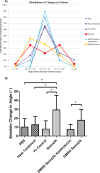Sema3A Reduces Sprouting of Adult Rod Photoreceptors In Vitro
- PMID: 28806446
- PMCID: PMC5555408
- DOI: 10.1167/iovs.16-21075
Sema3A Reduces Sprouting of Adult Rod Photoreceptors In Vitro
Erratum in
-
Erratum.Invest Ophthalmol Vis Sci. 2017 Sep 1;58(11):4799. doi: 10.1167/iovs.17-22948a. Invest Ophthalmol Vis Sci. 2017. PMID: 28973336 Free PMC article. No abstract available.
Abstract
Purpose: Rod photoreceptor terminals respond to retinal injury with retraction and sprouting. Since the guidance cue Semaphorin3A (Sema3A) is observed in the retina after injury, we asked whether Sema3A contributes to structural plasticity in rod photoreceptors.
Methods: We used Western blots and alkaline phosphatase (AP)-tagged neuropilin-1 (NPN-1) to detect the expression of Sema3A in an organotypic model of porcine retinal detachment. We then examined Sema3A binding to cultured salamander rod photoreceptors using AP-tagged Sema3A. For functional analysis, we used a microspritzer to apply a gradient of Sema3A-Fc to isolated salamander rod photoreceptors over 24 hours.
Results: Sema3A protein was biochemically detected in porcine retinal explants in the retina 7, 24, and 72 hours after detachment. In sections, NPN-1 receptor was bound to the inner and outer retina. For isolated rod photoreceptors, Sema3A localized to synaptic terminals and to neuritic processes after 1 week in vitro. In microspritzed rod photoreceptors, process initiation occurred away from high concentrations of Sema3A. Sema3A significantly decreased the number of processes formed by rod photoreceptors although the average length of processes was not affected. The cellular orientation of rod photoreceptors relative to the microspritzer also significantly changed over time; this effect was reduced with the Sema3A inhibitor, xanthofulvin.
Conclusion: Sema3A is expressed in the retina after detachment, binds to rod photoreceptors, affects cell orientation, and reduces photoreceptor process initiation in vitro. Our results suggest that Sema3A contributes to axonal retraction in retinal injury, whereas rod neuritic sprouting and regenerative synaptogenesis may require a reduction in semaphorin signaling.
Figures








Similar articles
-
LIM Kinase, a Newly Identified Regulator of Presynaptic Remodeling by Rod Photoreceptors After Injury.Invest Ophthalmol Vis Sci. 2015 Dec;56(13):7847-58. doi: 10.1167/iovs.15-17278. Invest Ophthalmol Vis Sci. 2015. PMID: 26658506 Free PMC article.
-
RhoA and its role in synaptic structural plasticity of isolated salamander photoreceptors.Invest Ophthalmol Vis Sci. 2008 Sep;49(9):4177-87. doi: 10.1167/iovs.07-1580. Epub 2008 May 23. Invest Ophthalmol Vis Sci. 2008. PMID: 18503000
-
Actin Dynamics, Regulated by RhoA-LIMK-Cofilin Signaling, Mediates Rod Photoreceptor Axonal Retraction After Retinal Injury.Invest Ophthalmol Vis Sci. 2019 May 1;60(6):2274-2285. doi: 10.1167/iovs.18-26077. Invest Ophthalmol Vis Sci. 2019. PMID: 31112612 Free PMC article.
-
The Chemorepulsive Protein Semaphorin 3A and Perineuronal Net-Mediated Plasticity.Neural Plast. 2016;2016:3679545. doi: 10.1155/2016/3679545. Epub 2016 Jan 14. Neural Plast. 2016. PMID: 27057361 Free PMC article. Review.
-
Seasonal and post-trauma remodeling in cone-dominant ground squirrel retina.Exp Eye Res. 2016 Sep;150:90-105. doi: 10.1016/j.exer.2016.01.011. Epub 2016 Jan 22. Exp Eye Res. 2016. PMID: 26808487 Free PMC article. Review.
Cited by
-
VEGF as a Direct Functional Regulator of Photoreceptors and Contributing Factor to Diabetes-Induced Alteration of Photoreceptor Function.Biomolecules. 2021 Jul 5;11(7):988. doi: 10.3390/biom11070988. Biomolecules. 2021. PMID: 34356612 Free PMC article.
-
Coming of Age for the Photoreceptor Synapse.Invest Ophthalmol Vis Sci. 2021 Sep 2;62(12):24. doi: 10.1167/iovs.62.12.24. Invest Ophthalmol Vis Sci. 2021. PMID: 34550300 Free PMC article.
-
Synaptic Remodeling in the Cone Pathway After Early Postnatal Horizontal Cell Ablation.Front Cell Neurosci. 2021 May 26;15:657594. doi: 10.3389/fncel.2021.657594. eCollection 2021. Front Cell Neurosci. 2021. PMID: 34122012 Free PMC article.
-
Primary Retinal Cell Cultures as a Model to Study Retina Biology.Adv Exp Med Biol. 2023;1415:565-569. doi: 10.1007/978-3-031-27681-1_82. Adv Exp Med Biol. 2023. PMID: 37440087 Review.
-
Efficacy of an Anti-Semaphorin 3A Neutralizing Antibody in a Male Experimental Retinal Vein Occlusion Mouse Model.Invest Ophthalmol Vis Sci. 2022 Jul 8;63(8):14. doi: 10.1167/iovs.63.8.14. Invest Ophthalmol Vis Sci. 2022. PMID: 35822950 Free PMC article.
References
-
- Marc RE, Jones BW, Watt CB, Strettoi E. . Neural remodeling in retinal degeneration. Prog Retin Eye Res. 2003; 22: 607– 655. - PubMed
-
- Fariss RN, Li Z-Y, Milam AH. . Abnormalities in rod photoreceptors, amacrine cells, and horizontal cells in human retinas with retinitis pigmentosa. Am J Ophthalmol. 2000; 129: 215– 223. - PubMed
-
- Sherry DM, St Jules RS, Townes-Anderson E. . Morphologic and neurochemical target selectivity of regenerating adult photoreceptors in vitro. J Comp Neurol. 1996; 376: 476– 488. - PubMed
Publication types
MeSH terms
Substances
Grants and funding
LinkOut - more resources
Full Text Sources
Other Literature Sources
Medical

